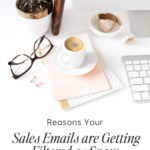Reasons Your Sales Emails are Getting Filtered as Spam (and What to Do About It)
Table of Contents
ToggleSharing is caring!
Reading Time: 4 minutes
Nothing frustrates an email marketer more than a thoughtfully-crafted email getting trapped in the spam filter. All that hard work wasted because your subscribers are not seeing your content.
The thing is, even the most compelling and attractive email can get caught in the spam folder. And this goes even if the recipient explicitly requested to receive marketing messages in their inbox. That's not to say it's impossible to evade the spam filter; you have to avoid making mistakes that are tripping email security. In this guide, we're outlining the most common reasons why sales emails are being filtered as spam and what you can do to solve the problem:

8 Reasons Why Sales Emails are Filtered as Spam
Mistake 1: Sending emails in bulk
All email platforms have triggers for mass emailing, especially if the messages are sent to people you've never contacted before. It's tempting to send emails in bulk, especially when you have many tasks to take care of, but it's best to let the emails drip out periodically to avoid being filtered into the spam folder. Email marketing software can set the intervals to every 15 minutes. You can also manually push a handful of emails every 10 to 15 minutes.
Mistake 2: Consistently low engagement
Did you know that email platforms like Gmail and Yahoo check user engagement to determine which emails go to the inbox and which are filtered in the spam folder?
One of the most common reasons your messages are being filtered could be the low engagement among recipients. This can be avoided by encouraging recipients to check their emails. Use clear calls to action, send quick replies, and be sure that the content is personalised and intriguing to get more people to open your emails. You can also hop over to your social media and create a quick clip to get people to check their spam folder for your emails and remove the spam tag.
Mistake 3: Creating image-heavy emails
Adding images to emails is a great way to make the text more engaging or entertaining, but too many photos might trigger the inbox providers' spam filters. Don't weigh your emails down with too many images. Use a good text-to-image ratio. A good text-to-image ratio is between 50/50 and 60/40 text and pictures. Play around with the format to determine which works for your audience.
Mistake 4: You're using spammy words
Did you know that email platforms can flag certain words as spam? Be extra careful about the language you use because some phrasing can come across as spammy such as “amazing deal,” “100% free,” “cancel anytime,” “dear friend,” “check money order,” or “buy direct.” Proofread the email, check the flow, and ensure it's original, engaging, and personalised. If a word sounds spammy, go to an online thesaurus and check for synonyms.
Mistake 5: Forgetting to add an unsubscribe link
While it's tempting to hang on to every subscriber and make it as hard as possible to unsubscribe from your awesome emails, you will be tagged as a spammer if you neglect to add an unsubscribe link. Inbox providers don't like it when you're not giving people the option to opt out of a subscription. Recipients must agree to receive marketing messages with a chance to cancel anytime.
As a business, it's equally important to honour the opt-out option by making it easy for subscribers to unsubscribers. Do not make people jump through hoops to prevent them from unsubscribing. This will come across as suspicious and spammy to email platforms.
Mistake 6: Using an outdated email list
How old is your mailing list? Not all people stick to one email address, and the emails you collected five years ago might no longer be as fresh. Some people could've switched emails; others lost their access, etc. According to some email providers, 25% of an email list will go bad in as short as one year. These email addresses become dormant accounts; they get hacked and turned into bots or become spam traps. That's why it's best to update your email list every month. Check which recipients haven't opened your messages in the past year and delete their email addresses from your list.
Mistake 7: You have a poor sender rep
Your reputation as a sender matters greatly to major email providers like Gmail or Yahoo! Mail. A sender's reputation is a score that an Internet Service Provider (ISP) assigns to a domain that sends emails. If your sender rep score is low, there's a good chance that your messages will fail to deliver.
To boost your sender rep, you need to stick to the quality of your email list (see above), your marketing habits and how subscribers interact with your marketing messages. How you interact with your subscribers matters too! Validate your email list, avoid email address typos (gnail.com, gmaik.com) and avoid temporary inboxes also helps improve your sender rep.
Mistake 8: You bought your email list
While it's much easier to buy or rent an email list instead of putting in the work and letting your email list grow organically, that's one way to being tagged as a spammer. Buying email addresses and sending unwanted sales messages will be detrimental to your marketing efforts. If people don't sign up for your marketing messages, they will be quick to mark your messages as spam. It's much better to market to a handful of people who signed up for your marketing messages than send bulk emails to 10K people who did not sign up for your marketing messages.
Understanding why your emails are being filtered as spam is crucial in solving the problem. Don't let your marketing efforts go to waste; apply the tips we've outlined above to improve your marketing campaigns and boost your sales!
Most Popular Posts:
Sharing is caring!
PLEASE COMMENT BELOW